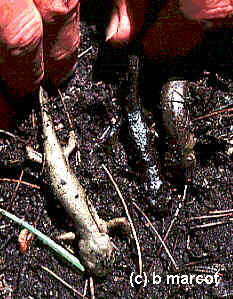

In the remote high country of the Klamath Mountains of northwestern California are found a series of small, hidden ponds. Within these ponds reside some bizarre forms of newts -- the polymorphic (many-formed, or many-colored) forms of the northern rough-skinned newt (Taricha g. granulosa):
First identified by the wildlife biologist David Garber back in the 1970's, these specimens had again been swallowed by their remoteness, until they were finally photographed and further studied by my colleagues and me. As I discussed in the textbook Wildlife Habitat Relationships: Concepts and Applications, Second Edition, it is still unknown what formed and maintains this unique set of polymorphic populations.

Rough-skinned newts are usually brownish to blackish on their dorsum (back), and orange-bellied, but these oddities range widely in coloration, even within single, assumedly interbreeding populations. These photos shows some of the variation from one pond.
As I wrote,
The causes of the color morphs are unknown; hypothetically, they may be due to selective reproduction, genetic effects of immigrants, length of time isolated, or other factors. These particular populations number approximately 1500-2000 individuals each and are likely to be largely panmictic, so inbreeding and genetic drift probably are not major factors causing the morphs, although the morphs may have a genetic basis. Other causes of the color variants may be some unknown selection mechanism such as differential vulnerability to predation (although this seems unlikely), or a differential phenotypic response to some environmental condition such as to ultraviolet solar radiation. Their occurrence in higher-elevation lakes may suggest a harsher environment and potentially greater influence of ultraviolet radiation. Or it may be that higher elevation populations are more isolated than lower elevation populations, and can thus develop color morphs because of that isolation. Only further studies would reveal the true case.
Back to the WHR Book
Page ...
Back to The Plexus Home Page ...